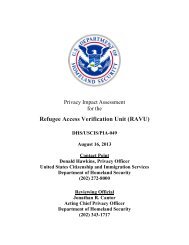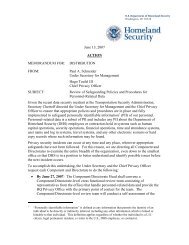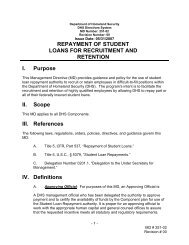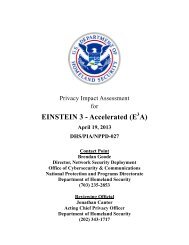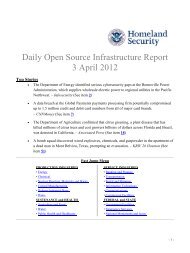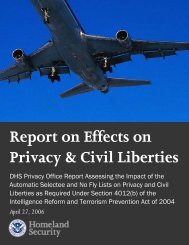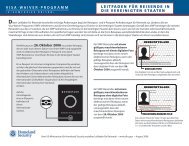Exodus Accountability Referral System (EARS) - Homeland Security
Exodus Accountability Referral System (EARS) - Homeland Security
Exodus Accountability Referral System (EARS) - Homeland Security
You also want an ePaper? Increase the reach of your titles
YUMPU automatically turns print PDFs into web optimized ePapers that Google loves.
Privacy Impact Assessment<br />
ICE, <strong>Exodus</strong> <strong>Accountability</strong> <strong>Referral</strong> <strong>System</strong><br />
Page 7<br />
1.5 How will the information be checked for accuracy?<br />
As federal law enforcement officers, ICE agents and CBP officers are trained to fully check all<br />
original data sources and further investigate or inquire to resolve any anomalies that are detected.<br />
Standard operating procedures for ICE agents emphasize the importance of verifying information that is<br />
obtained during the course of an investigation. Information from a referral is provided by a federal<br />
regulatory agency.<br />
The information that is provided to ICE by the licensing agencies in response to an <strong>EARS</strong> referral<br />
is obtained or maintained by those agencies under specific legislative authority. The original data<br />
collector is responsible for maintaining and checking the accuracy of its own data and has various means<br />
to do so.<br />
1.6 What specific legal authorities, arrangements, and/or<br />
agreements defined the collection of information?<br />
The legal authorities that authorize the collection of information are the primary federal export<br />
control laws enforced by ICE and CBP, specifically the Arms Export Control Act (22 U.S.C. § 2778), the<br />
Export Administration Act (50 U.S.C. § 2410), the International Emergency Economic Powers Act (50<br />
U.S.C. § 1701), and the Smuggling of Goods from the United States (18 U.S.C. § 554). ICE and CBP<br />
law enforcement personnel are authorized to enforce these laws pursuant to 22 C.F.R. § 127.4.<br />
1.7 Privacy Impact Analysis: Given the amount and type of<br />
data collected, discuss the privacy risks identified and how<br />
they were mitigated.<br />
Privacy Risk: There is a risk that the information collected could be misused and or accessed by<br />
unauthorized persons.<br />
Mitigation: The data collected and maintained in <strong>EARS</strong> is collected in the course of normal<br />
investigative and inspectional duties. Standard access controls are in place to prevent misuse of the<br />
system and only authorized ICE and CBP personnel have access. <strong>EARS</strong> system users are assigned<br />
individual user IDs and passwords and the system is only available via a DHS local area network.<br />
Management controls are in place to ensure that only complete and necessary inquiries are sent to the<br />
responsible federal regulatory agency(ies) that grant licenses.<br />
Privacy Risk: There is a potential risk for a lack of accurate and complete information collected<br />
and maintained.<br />
Mitigation: The ECC Program Manager must review and approve each new referral before it is<br />
submitted to the responsible licensing agency. This helps to ensure the referrals are complete and contain<br />
the necessary information. While <strong>EARS</strong> referrals support ICE investigations and CBP inquiries, they are<br />
only one component of a complete criminal investigation. ICE agents fully investigate suspected criminal<br />
violations of federal export control laws to ensure they have complete information before taking any





